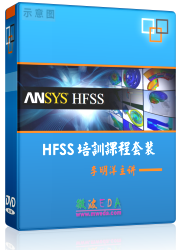Assigning Boundaries
Boundary conditions specify the field behavior at the edges of the problem region and object interfaces. HFSS and HFSS-IE designs have different menu options for boundaries.
Within the context of HFSS and HFSS-IE, boundaries exist for two main purposes:
1. to create either an open or a closed electromagnetic model or,
2. to simplify the electromagnetic or geometric complexity of the electromagnetic model.
Click here for HFSS-IE boundaries.
You may assign the following types of boundaries to an HFSS design:
Perfect E |
Represents a perfectly conducting surface. |
Perfect H |
Represents a surface on which the tangential component of the H-field is the same on both sides. |
Impedance |
Represents a resistive surface. |
Radiation |
Represents an open boundary by means of an absorbing boundary condition (ABC) that absorbs outgoing waves. |
PML |
Represents an open boundary condition using several layers of specialized materials that absorb outgoing waves. |
Finite Conductivity |
Represents an imperfect conductor. |
Symmetry |
Represents a perfect E or perfect H plane of symmetry. |
Master |
Represents a surface on which the E-field at each point is matched to another surface (the slave boundary) to within a phase difference. |
Slave |
Represents a surface on which the E-field at each point has been forced to match the E-field of another surface (the master boundary) to within a phase difference. |
Lumped RLC |
Represents any combination of lumped resistor, inductor, and/or capacitor in parallel on a surface. |
Anisotropic Impedance |
Represents a boundary condition used to replace a surface a planar screen or grid with periodic geometry. |
Layered Impedance |
Represents a structure with multiple layers as one impedance surface. |
IE Region |
Represents a conductor or dielectric that you assign to be solved using the IE solver. |
You may also choose to designate a perfect E, finite conductivity, or impedance boundary as an infinite ground plane if you want the surface to represent an electrically large ground plane when the radiated fields are calculated during post processing.
Note |
Hiding boundaries also turns off a check for boundary overlaps during boundary assignment. In the case of very large models with many boundaries, hiding boundaries can prevent delays during boundary assignment. Full model validation will subsequently check for boundary overlaps. |
For convenience, you can access the Edit Global Materials command from the Boundaries menu.
Note |
By default, the history tree in the 3D modeler window groups sheet objects according to boundary assignment. To change this, select the Sheets icon and right-click to display the Group Sheets by Assignment checkbox. |
Related Topics
Technical Notes: Boundaries
Zoom to Selected Boundary
Setting Default Boundary Base Names
Designating Infinite Ground Planes
Modifying Boundaries
Deleting Boundaries
Reassigning Boundaries
Reprioritizing Boundaries
Edit Global Materials Environment
Duplicating Boundaries and Excitations with Geometry
Showing and Hiding Boundaries and Excitations
Reviewing Boundaries and Excitations in the Solver View
Setting Default Values for Boundaries and Excitations
Assigning HFSS-IE Boundaries
-

国内最全面的HFSS培训课程,包含7套视频教程和2本教材,资深专家讲解,视频操作演示,结合最新工程案例,让HFSS学习不再难...【详细介绍】





